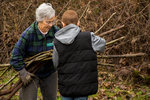
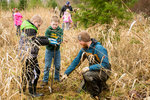
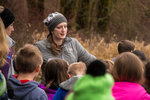
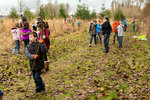
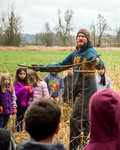
With mud flying and while surrounded by children wielding tools akin to heavy-duty pogo sticks, Brandon Bywater of the Nisqually River Education Project couldn’t help but crack a smile.
“For me, the number one goal is that the kids are having fun outdoors,” Bywater said. “Hopefully, they leave having learned something, too.”
The kids Bywater spoke of consisted of the entire fourth grade class from Simpson Elementary School in Montesano. The school tries to bring that grade to Centralia each year for a day of planting trees along the Discovery Trail.
Representatives from the Chehalis River Basin Land Trust, Chehalis Basin Education Consortium and others helped to facilitate the experience on Thursday.
Under the watchful guidance of Bywater, Rachel Stendahl of the CBEC and a dozen other adult volunteers, students bored holes in the ground and planted tree starts, dotting the reed canary grass with barren sticks measuring about a yard in length.
Local volunteers worked Monday to clear circular areas within the thick brush so the children could reach the soil beneath.
Sporting colorful rain boots and jackets, the kids enjoyed a few minutes of stomping through the mud and play-fighting with their work gloves before Stendahl got their attention for a short introduction.
“It’s a controlled chaos,” said Jan Robinson, president of the CRBLT board of directors, as she helped distribute gloves and tools. “But that’s a good thing. Between this and the field studies that happen in the spring, it’s always great to get the kids out here.”
Longtime Simpson Elementary teacher Tina Niels pointed out trees along the trail her past students had planted as fourth-graders more than a decade ago. She helped a group of students space out their tree starts while explaining how the experience helps lock in the units on ecology and wildlife biology she teaches each year.
Children who Simpson Elementary learn about riparian zones — areas of vegetation along river banks that separates the waterway from the land — and the life cycle of salmon. They do water testing exercises twice a year.
Niels said her goal is that by the end of each school year, her students know which plants they see are native to the Pacific Northwest and which are not.
“I’m going to remember how fun it was to plant the trees with the digger tools and put the sticks in the ground,” Zayden Moreau said. “Also, how the trees can help the environment.”
The students were split into two groups Thursday. One spent the morning out on the trail, while the other received a tour of the wastewater treatment plant operated by the city of Centralia. After a lunch break, the two clusters swapped roles for the remainder of the afternoon.
On the tour, students saw how wastewater enters the facility, gets filtered, treated and released back out into the water supply. Employees showed off the laboratory space where they keep the bacteria used to treat contaminated water.
The city and CRBLT partnered to create the Discovery Trail through a conservation easement awarded in conjunction with efforts to build the wastewater treatment plant about 15 years ago. The U.S. Fish and Wildlife Service, Washington State Salmon Recovery Funding Board and other groups also helped bring the 1.5 miles of nature walk to fruition.
“Getting to plant, see, and understand what happens out here is really good for the kids,” Niels said. “Pictures in a book are not the same thing. This feeds into all of the things they learn, and helps them feel connected to to it all.”
Having dotted a section of the brush with what will hopefully become another stretch of greenery rising above the fray, the children headed back to the opening along the trail where a school bus would pick them up and return them to Montesano. Muddied, but not rained on, everyone smiled for a group picture while they waited for their ride.
They had time to take a few pictures, and for everyone to use the restroom. The bus had gotten stuck in the mud while driving up the unpaved roadway. A backhoe was summoned to tow it out of the muck.
While an inconvenience to be sure, the scene had the full attention of each student, and might have made it more likely they’ll remember the field trip for years to come.